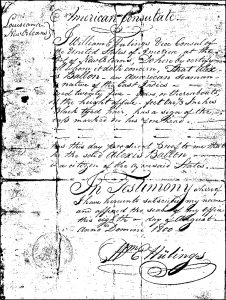Good news on seamen’s certificates
So yesterday The Legal Genealogist did it again.
Gave people a taste for a neat new record group… and didn’t provide all the available information about accessing it.
The records are the proofs of citizenship for seamen’s protection certificates — records kept by the federal government of certificates of citizenship issued to sailors to try to protect them from impressment into foreign service.1
 Part of Record Group 36, the Records of the Bureau of Customs at the National Archives and Records Administration, these documents exist from a number of early port cities, among them Bath, Maine; Boston, Massachusetts; New Bedford, Massachusetts; New Orleans, Louisiana; New York City; Philadelphia, Pennsylvania; and Portsmouth, New Hampshire.
Part of Record Group 36, the Records of the Bureau of Customs at the National Archives and Records Administration, these documents exist from a number of early port cities, among them Bath, Maine; Boston, Massachusetts; New Bedford, Massachusetts; New Orleans, Louisiana; New York City; Philadelphia, Pennsylvania; and Portsmouth, New Hampshire.
The question is: how do you get into these records if they’re not indexed?
The answer is: many of them are indexed. But you may have to hunt to find the index you need.
First of all, the records from Bath, Maine, and Portsmouth, New Hampshire, are already indexed on FamilySearch.2 And others are being indexed currently by volunteers so more indexes will become available on this free site in the future.3
Second, the records from Bath and Portsmouth plus those from New Orleans and Philadelphia are indexed on Ancestry.4 That database also includes the quarterly abstracts from New York City.
Third, there is a published index to the Philadelphia records from Ruth Priest Dixon that you may be able to find in a library or even (gasp) buy for your own library.5
Her later work indexing the records at New Orleans, Mobile, Alexandria and a number of New England ports is also available on Ancestry.6
Likewise, a published version of the card index for the Providence, Rhode Island, records has been digitized and is available on Ancestry.7
And, if all else fails, there’s always the 153 linear feet of three-by-five cards in the index at the National Archives at Washington, D.C.
In short, there are ways to find out if your seagoing ancestor had one of these certificates.
Sometimes even in bunny slippers at 3 a.m.
SOURCES
- Judy G. Russell, “Sailing away,” The Legal Genealogist, posted 28 July 2016 (https://www.legalgenealogist.com/blog : accessed 29 July 2016). ↩
- Digital images, “Maine, Bath, Seamen’s Proofs of Citizenship, 1833-1868,” FamilySearch (https://familysearch.org : accessed 28 July 2016). ↩
- You are helping with the indexing of some of these records, right? See e.g. Judy G. Russell, “The final numbers,” The Legal Genealogist, posted 21 July 2016 (https://www.legalgenealogist.com/blog : accessed 28 July 2016). ↩
- Digital images, “U.S., Citizenship Affidavits of US-born Seamen at Select Ports, 1792-1869,” Ancestry.com (http://www.ancestry.com : accessed 28 July 2016). A tip of the hat to Chad Milliner of Ancestry for that info. ↩
- Ruth Priest Dixon, Index to Seamen’s Protection Certificate Applications, Port of Philadelphia, 1824-1861 (Baltimore, Md. : Genealogical Pub. Co., 1994). A tip of the hat to Marie Varrelman Melchiori, Certified Genealogist Emeritus, for that information. ↩
- Ruth Priest Dixon, Indexes to Seamen’s Protection Certificate Applications and Proofs of Citizenship… (Baltimore, Md. : Clearfield, 1998); digital images, “Indexes to Seamen’s Protection Certificate Applications and Proofs of Citizenship,” Ancestry.com (http://www.ancestry.com : accessed 28 July 2016). ↩
- Rhode Island Historical Society, Register of Seamen’s Protection Certificates from the Providence, Rhode Island, Custom District, 1796-1870 (Baltimore, Md. : Clearfield, 1995); digital images, “Register of Seamen’s Protection Certificates from the Providence, Rhode Island Customs District, 1796-1870,” Ancestry.com (http://www.ancestry.com : accessed 28 July 2016). ↩



This was interesting to me because I remember reading about them in a novel. It MAY have been in the Ramage series by Dudley Pope, a British Naval Historian. It was a part of the plot that one of the sailors (American) had an extra “protection” that he gave to his captain during a rather daring escapade.
The certificates are very important in African American research long after the War of 1812.
Curiously, they are used to study the history of tattoos.
I found a possible ancestor on the New York list. How do I find all the information about this person?
As the blog post says, these records are in Record Group 36, the Records of the Bureau of Customs at the National Archives and Records Administration, Archives I, in Washington, D.C. You can contact the archivists by email (Archives1reference@nara.gov) to ask for the form to order the record or hire a researcher to follow up for you.
Mystic Seaport Museum has a digitized list of some Seaman’s Protection agreements for certain eastern ports to 1871.
https://research.mysticseaport.org/databases/protection/